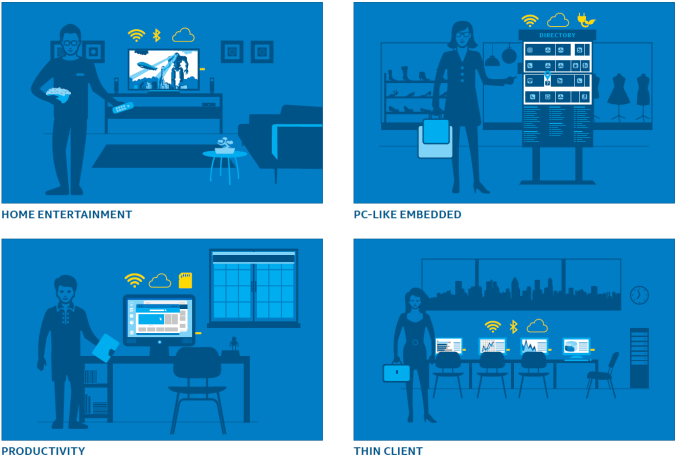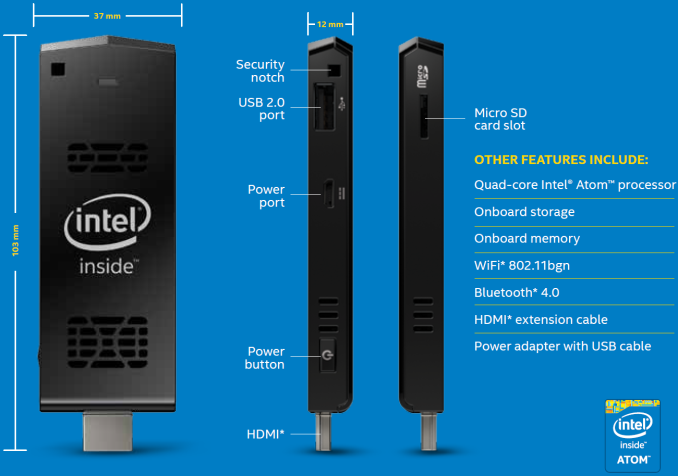Intel PPSTCK1A32WFC Bay Trail-T Compute Stick Review
by Ganesh T S on April 22, 2015 11:00 AM EST- Posted in
- Systems
- Intel
- Bay Trail
- HDMI Stick
Concluding Remarks
The Intel Compute Stick gave us the opportunity to see whether a tablet SoC could provide enough horsepower for a desktop PC. Based on our experience, the answer to that question is cautiously in the affirmative. There is no doubt that the device can do well as an economical solution for thin clients, kiosks and digital signage. These are scenarios where only one program runs for the life of the system and the OS is rarely updated.
The Compute Stick could do with some improvements for the scenarios in the left column
Traditional PCs have a different use-case compared to PC-like embedded systems and that brings us to the first problem in the Compute Stick we reviewed:
- OS drive size
32 GB, simply put, is just not enough after Windows installs a couple of updates. Out of the box, the system had around 17 GB free in the 23 GB disk (the rest, presumably, is the OS recovery partition). An initial update check resulted in a 1.3 GB download, and that installation brought down the free space to 14.3 GB. We have always been wary of Windows Updates on machines with low free space on the primary drive. As feared, attempting to install another round of updates resulted in a botched update problem (solved here). We had to spend 4+ hours getting the unit back to the initial state with a 'refresh' operation (and reinstall all the updates once again). To top it off, Windows lost activation in the refresh process and refused to reactivate (indicating a blacklisted key).
- Thermal design / solution
There is no doubt that the thermal design is very effective. Acoustic measurements come in at 28 dB at 1m distance. However, the irregular nature of the small-diameter fan makes for a strained experience if the user sits very close to the Compute Stick (possible in an office environment). It would not be a bad idea to go for a passively cooled Compute Stick at the cost of a slight increase in cost, weight and/or size.
- WLAN solution
The unit doesn't come with any wired networking facilities. It is essential that the Wi-Fi solution be top-notch. Unfortunately, a single-band 1x1 802.11n solution just doesn't cut it - particularly for scenarios involving video streaming. Thankfully, the presence of Bluetooth makes a USB keyboard / mouse unnecessary, freeing up the single USB 2.0 port for other purposes. Talking of video streaming, it would also be nice to have full HD audio support in the GPU drivers for Bay Trail-T (now that it has made its appearance in a mini-PC).
Despite the above shortcomings, the Compute Stick did impress us in a few areas - the form factor and portability aspects are praiseworthy. The CPU performance is not as bad as we feared it would be - Windows loads in a smooth manner and the system is as responsive as what one can expect from a Bay Trail-based mini-PC.
Coming to the business end of the review, we can say that the Intel Compute Stick is a typical first-generation product. In our opinion, there are way too many compromises being made to get to this form factor. There are certainly applications where the kit would be perfect, but general-purpose day-to-day computing is not one of them. If Intel wants the Compute Stick product line to take off like NUCs, addressing the three main shortcomings detailed above would be a good first step.












103 Comments
View All Comments
watzupken - Wednesday, April 22, 2015 - link
Looking at the performance as a whole, it is nowhere near impressive. But if you consider the price of this, there is not much to complain to be honest. I am looking forward to something like this with the new Cherry Trail chip to use as my HTPC.mathew7 - Thursday, April 23, 2015 - link
Are there any interoperability issues with BT and WIFI? I'm asking because I have a Tronsmart 4-core stick (actually 2) and when I am connected to 2.4GHz Wifi and use a BT mouse, I cannot watch anything. I noticed this first with HBO go, where using a BT mouse would result in not playing. but even in play store I had lots of "retry" messages.Then I saw this about a Hanspree clone: http://www.amazon.co.uk/review/RQORH45TGR8KU/ref=c...
"The WiFi and Bluetooth can get a bit flaky if used together. Using one causes the other to slow down or drop out completely. I've got a USB network adapter attached so I can use a bluetooth controller. Those wanting to use this as a steam machine might want to either do the same, or use a wireless 360 controller with its adapter to avoid using the bluetooth and WiFi together."
This led me to the conclusion that 1x1 2.4GHz radio cannot work reliably with BT and Wifi.
mathew7 - Thursday, April 23, 2015 - link
Strange to reply to my own mail.But I've seen some posts about people realizing a slower Wifi connection when BT is active (even about Apple devices).
So maybe this stick does has a stable connection, but the wifi performance is degraded by Bluetooth activity.
So please, please, tell us how you tested (BT mouse+KB ?) and also report the other way. This is really important for this class of devices.
ganeshts - Friday, April 24, 2015 - link
I got curious and tested out by disabling Bluetooth completely. Peak TCP Wi-Fi performance with our test router gave around 15 Mbps in the same physical setting. A slight improvement, but I suspect the BT interference is not that bad in the Compute Stick.mathew7 - Monday, April 27, 2015 - link
Actually, in my experience, it's the BT transfer that's problematic. As in: if I click on something and don't move the mouse, it works correctly, but if I keep moving the mouse, cursor is jerky and network problems appear.So you tested with BT completely off....it is a good info. But did you also move the BT mouse while testing?
SilverBlade - Thursday, April 23, 2015 - link
Saying that the absence of HD audio bitstreaming will not bother too many consumers is flat out entirely false.Any HTPC MUST have the ability to bitstream HD audio. It is a 100% REQUIRED and ESSENTIAL ability.
Why bother having an HTPC that can only output DVD quality? Makes zero sense. May as well get a proper blu-ray player or a media player from 5 years ago that is quite capable of bitstreaming HD audio.
It is a complete and utter fail.
Sorry, Intel screwed this up. This is entirely, 100% useless to me until they give it the ability to bitstream HD audio.
mathew7 - Thursday, April 23, 2015 - link
So I guess you don't travel and use the hotel's (maybe) stereo TV, where HD audio is impossible.To listen to HD audio you already need a serious 5.1 (or more) receiver, which means size does not really matter and most likely you already have a BD player. So go buy the NUC.
Also videos with HD audio tracks need so much storage that the compactness of this device is useless , as it can't power directly a 2.5"HDD or BD reader, which means you need an additional power brick. This is before I get to the single USB port.
ganeshts - Friday, April 24, 2015 - link
Having HD audio bitstream would be nice, but, if you are having an AVR capable of bitstreaming I strongly suggest you spend a little more and get a NUC or some other 'capable' HTPC for playback purposes.Anyways, Netflix DD+ bitstreaming works.
Tranzaction77 - Thursday, April 23, 2015 - link
The Netbook of Compute Sticks.damianrobertjones - Thursday, April 23, 2015 - link
"32 GB, simply put, is just not enough after Windows installs a couple of updates."Although I do agree there are other options. Remove the recovery partition, disable virtual memory, disable hibernation etc to grab back all of the space. Also after installing updates run disk cleanup to recover even more space taken by the updates.
Not sure why this is never mentioned.